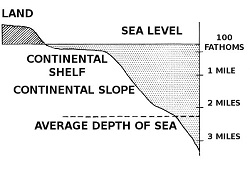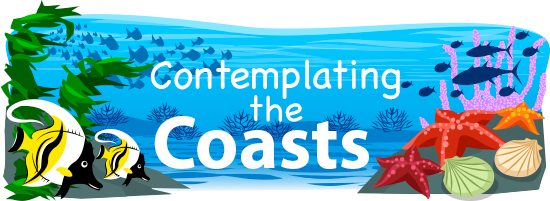A Sea of Plenty

At the coast, land meets sea, fresh water meets salt water, and light trickles to the ocean floor. Because of this mixed meeting of different factors, the coast is very productive.
This means these seas have plenty of food, light, and nutrients to feed many types of organisms.
The coastal biome has two fairly well defined borders: the high water line near on the shore, and the steep edge of the underwater continental shelf far offshore.

The border on shore is the intertidal zone, or the area that is sometimes exposed to the air during low tide. These tides flood and recede on a roughly 12-hour cycle because the gravity of the moon pushes ocean water around the planet.
Past the underwater continental shelf the water quickly becomes too deep for light to reach the bottom, so fewer organisms live there. Between these boundaries many creatures build their homes, which can be in coral reefs, oyster beds, kelp forests, sea grass meadows, or soft sandy habitats.
Flowing Waters
Whenever it rains on land, the fresh water flows downhill creating streams. These streams meet and create bigger and bigger rivers until they get to the sea.
If you've been to a large river, like the Mississippi, you know that river water isn't always clear. By the time fresh river water reaches the ocean, it has picked up dirt, silt, and minerals. This water often brings important nutrients to the tiny organisms living in the salty ocean water.

On the seaward side of the coastal biome, far away from shore and its rivers of fresh water, ocean currents carry more nutrients to the coast. These currents bring nutrients from the bottom of the ocean up to the coastal shelf where sun-loving organisms can use it for food. The movement of these nutrient-rich currents is called upwelling.
Under the Sun
The last piece of the productivity puzzle is sunlight. Even under water, sunlight is important for plants and animals to survive. Because sunlight shines through shallow coastal waters, this area is home to algae and phytoplankton. These organisms can use light and nutrients to make their own food. Algae and plankton then become food for larger animals like fish, clams, corals, whales, sharks, sea turtles, and even seabirds. More than half of the species on the planet live in the marine biome. Because of how productive coastal waters are, the coastal biome is home to a huge portion of these marine species.
Additional images via Wikimedia Commons. Gasflame nudibranch by Seascapeza.
Read more about: Contemplating the Coasts
Bibliographic details:
- Article: Anatomy of the Coast
- Author(s): Dr. Biology
- Publisher: Arizona State University School of Life Sciences Ask A Biologist
- Site name: ASU - Ask A Biologist
- Date published:
- Date accessed:
- Link: https://askabiologist.asu.edu/anatomy-coast
APA Style
Dr. Biology. (). Anatomy of the Coast. ASU - Ask A Biologist. Retrieved from https://askabiologist.asu.edu/anatomy-coast
Chicago Manual of Style
Dr. Biology. "Anatomy of the Coast". ASU - Ask A Biologist. . https://askabiologist.asu.edu/anatomy-coast
Dr. Biology. "Anatomy of the Coast". ASU - Ask A Biologist. . ASU - Ask A Biologist, Web. https://askabiologist.asu.edu/anatomy-coast
MLA 2017 Style

Some animals, like many nudibranchs, can live in shallow coastal waters or in deeper waters of the ocean.
Be Part of
Ask A Biologist
By volunteering, or simply sending us feedback on the site. Scientists, teachers, writers, illustrators, and translators are all important to the program. If you are interested in helping with the website we have a Volunteers page to get the process started.

